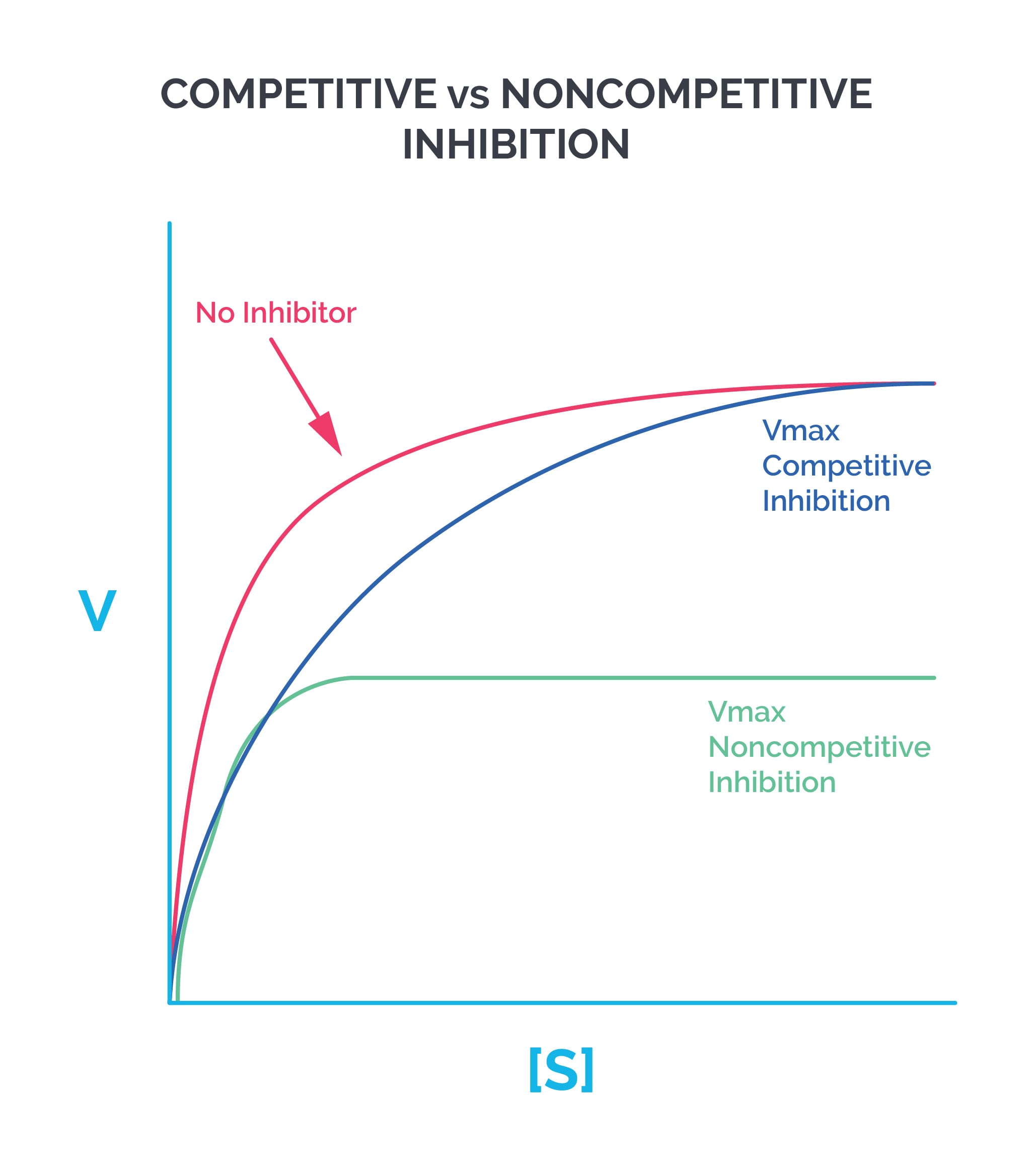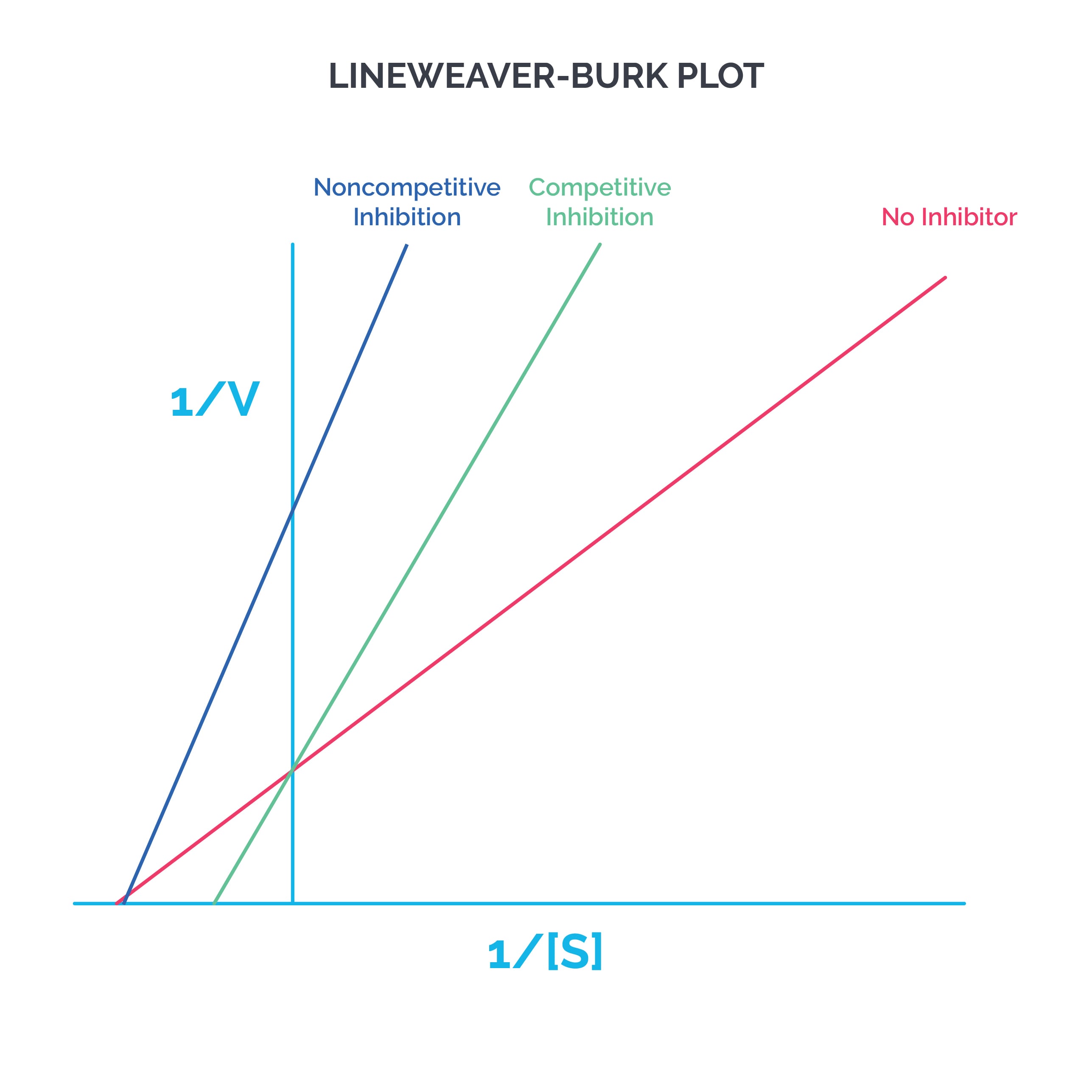Enzymes are protein catalysts that increase the rate of reactions. Enzymes provide an energetically favorable pathway for a reaction. They reduce the free energy of activation so that reactions can proceed easily. RNAs with catalytic activity are called ribozymes.
The active site of an enzyme is its substrate binding site. Kcat is the number of molecules of substrate converted to product per enzyme molecule per second.
Holoenzyme: active enzyme with its nonprotein component
Apoenzyme: inactive enzyme without its non-protein component
Cofactors: metal ion like iron, copper that forms the non-protein component of an enzyme
Coenzyme: small organic molecule that forms the non-protein component of an enzyme
Cosubstrate: a coenzyme which is temporarily associated with a substrate e.g. NAD
Prosthetic Group: a coenzyme that is permanently associated with the enzyme e.g. FAD
Effect Of Substrate Concentration On Enzymes: Enzymes that follow Michaelis -Menten kinetics show a hyperbolic graph when substrate concentration (S) on X axis is plotted against V (velocity of reaction) on the Y axis. Allosteric enzymes will produce a sigmoidal curve when plotted similarly.
The levelling of rate of reaction in the hyperbolic curve at high substrate concentrations is due to saturation of the all available active substrate binding sites on the enzyme. Rate of reaction is directly proportional to the enzyme concentration.
Km is the Michaelis–Menton Constant. It is equal to the substrate concentration at which the reaction velocity is half of Vmax.
Small Km = High Affinity Large Km = Low Affinity
The Lineweaver- Burk graph is plotted with 1/S on the X axis and 1/V on the Y axis.
Enzyme Inhibition:
i) Irreversible inhibitors bind to enzymes through covalent bonds.
ii) Reversible inhibitors bind to enzymes through non-covalent bonds.
There are two types of Reversible Inhibition – Competitive and Noncompetitive.
Competitive inhibition: Inhibitor binds to the same site as the substrate. Vmax stays the same while Km increases (affinity decreases). X intercept gets smaller while Y intercept stays the same. e.g. Statins and HMG CoA reductase.

NonCompetitive Inhibition: Inhibitor binds to a different site than enzyme. Reduces Vmax but Km remains the same. Y intercept gets larger while X intercept remains the same. e.g. Ferrochelatase is inhibited by lead which forms bonds with cysteine in the enzyme.

Tip: If the lines cross it is competitive inhibition and if the lines do not cross it is noncompetitive inhibition. Note that the graphs of irreversible competitive inhibition and noncompetitive inhibition will be the same.
Regulation of enzyme activity:
i) Allosteric Enzymes: Effectors or modifiers bind noncovalently at a site other than active site called an allosteric site. Can be positive or negative effectors.
Homotropic effectors: The substrate itself serves as an effector. Usually it acts like a positive effector and its binding on one site of the enzyme increases the catalytic activity of the other substrate binding sites (cooperative kinetics). These enzymes will show a sigmoidal V versus S curve.
Heterotropic effectors: Effector is not the substrate. Acts in feedback regulation.

In the above figure, the enzyme that converts D to E has an allosteric site that binds the end product G. If the conc of G increases, then the first irreversible step of the pathway is inhibited.
e.g. PFK 1 by Citrate.
ii) Other methods of regulating enzyme activity are covalent modification, adding or removing phosphate groups at serine, threonine or tyrosine residues of the enzyme by kinases and phosphatases respectively, and by inducing or repressing enzyme synthesis.
Delta G: Delta G is the change in free energy. If it is negative there is a net loss of energy and the reaction proceeds spontaneously. This type of reaction is also called exergonic reaction. If it is a positive number, there is a net gain of energy and the reaction does not go spontaneously, also known as endergonic reaction. Anabolic processes are endergonic reactions while catabolic processes that release energy like fatty acid oxidation are exergonic reactions.
When delta G is zero, the reactants are in equilibrium. All reactions continue till delta G becomes zero. The free energy of the forward reaction is equal in magnitude but opposite in sign to that of the back reaction. Delta G depends on the concentration of reactants and products, temperature and pressure. A reaction with a positive G can move forward if the ratio of the products to reactants is sufficiently small. G of consecutive reactions is additive e.g. first reaction is -4000 and next is +400 then total G will be – 3600. G s of pathways are additive. Enzymes help to lower the activation energies thus increasing the rate of a reaction. Enzymes do not change the free energy (delta G), in the reaction.
Solve the example below:
∆G°
V↔W -4.0
W↔X +0.4
X↔Y -3.4
Y↔Z +5.7
From the values of ∆G° given in the table, which compound in the overall metabolic pathway V↔W↔X↔Y↔Z will accumulate in the largest amount at equilibrium?
A) V
B) W
C) X
D) Y
E) Z
Answer is option D or product Y. As Y needs the most energy to overcome the positive energy (+5.7) of reaction to go from Y to Z, hence Y will accumulate. If you look at the reaction as a whole from V to Z , then -4+0.4-3.4+5.7 = (-1.3), in other words, the reaction as a series is likely to proceed since the delta G of the series is negative. This is what is seen in most human metabolic pathways. For pathways to proceed , delta G needs to be negative. Enzymes have a role in the specific reactions e.g. Y to Z which needs +5.7, where an enzyme can decrease the energy of activation.
Sign up for free to take 1 quiz question on this topic